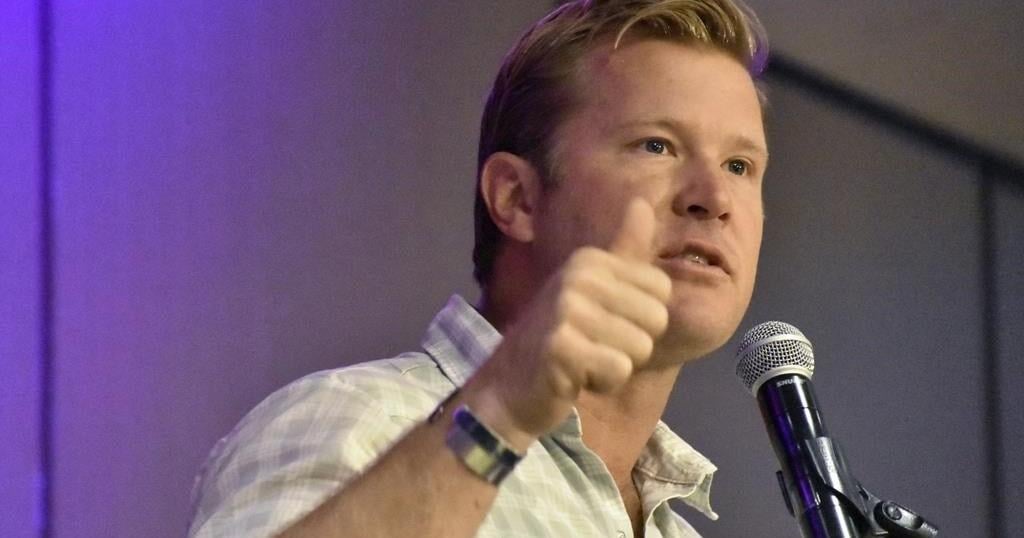BILLINGS, Mont. (AP) — Montana Republican U.S. Senate candidate Tim Sheehy acknowledged Monday that derogatory remark s he made last year about Native Americans were “insensitive.” But Sheehy rejected his opponent’s call to apologize, during a contentious debate in a race that’s emerged as pivotal for control of the Senate.
Three-term incumbent U.S. Sen. Jon Tester had challenged Sheehy over remarks last year in which the Republican told a group of laughing supporters about bonding “with all the Indians…while they’re drunk,” while working cattle at a ranch on the Crow Indian Reservation
“Yeah, insensitive,” responded Sheehy, a former U.S. Navy SEAL. “I come from the military as many of our tribal members do. You know, we make insensitive jokes and probably off color-jokes sometimes.”
Sheehy then tried to turn the discussion to the immigration crisis but Tester kept pressing him.
“Tim, the statement you made degrades Native Americans across this country,” Tester said. “You’re a big guy, just apologize.”
“You apologize for opening the border,” Sheehy retorted.
The acrimonious exchange, during the debate’s closing minutes, underscored the growing tensions between the two campaigns as the contest enters its final stretch. They are each jockeying for support from a small contingent of moderate Republican and Independent voters in the state who are considered crucial to victory in November.
Sheehy sharply criticized Tester over his ties to lobbyists, who have donated more heavily to the Democrat this election cycle than to any other member of Congress, according to the non-partisan group OpenSecrets.
“While I was fighting in Afghanistan, he was eating lobbyist steak in D.C.,” Sheehy said.
Tester in turn accused Sheehy of wanting to outlaw abortion, even as the Democrat linked his own campaign to a voter initiative that would enshrine abortion as a right under the state Constitution.
“I want to see Roe reinstated,” Tester said of the U.S. Supreme Court decision overturning Roe v. Wade that has allowed some states to sharply restrict abortions. “My opponent, on the other hand, feels exactly the opposite. He feels he’s more entitled to make that decision than the women are.”
Tester is the last remaining Democrat to hold high office in Montana and the race is on track to be the most expensive in state history. Republicans party leaders including former President Donald Trump handpicked Sheehy in hopes of toppling Tester, a 68-year-old farmer.
Republicans need to gain just two seats in November to take the Senate majority when a new Congress convenes next year. They are widely considered to have a lock on one, in West Virginia, meaning Montana could make the difference.
Montana has seven Indian reservations and almost 70,000 Native Americans, representing about 7% of its total population, according to U.S. Census data. It’s a voting block that’s long been considered Democratic-leaning. Montana Republicans in recent years have courted tribal leaders hoping to gain their support in elections.
Tribal leaders were highly critical of Sheehy’s derogatory comments about Native Americans that emerged in audio recordings published by Char-Koosta News, the official publication of the Flathead Indian Reservation.
Sheehy did not respond when the Rocky Mountain Tribal Leaders Council asked him to apologize in early September. The council represents 11 tribes and First Nations in the U.S. and Canada.
Sheehy later downplayed the comments during a Fox News interview in which he suggested the audio was from “years ago” and had been edited to make him sound “like somebody I’m not.” But he did not deny the authenticity of the recordings on Monday.
Trump won Montana by about 17 percentage points in 2020. Seeking to capitalize on the former president’s popularity in the state, Sheehy has frequently sought to lump Tester with President Joe Biden and Vice President Kamala Harris. The Republican’s objective is to highlight public dissatisfaction over the administration’s struggles to stem illegal immigration on the southern border.
“Democrats on the Hill refused to hold the administration accountable for the largest mass migration in the history of this country,” Sheehy said in response to a debate question about the border.
Seeking to blunt the attacks, Tester skipped the Democratic National Convention last month, declined to endorse Harris and avoids mention of her on the campaign trail. He’s opposed the administration over tighter pollution rules for coal plants and pressed it to do more on immigration.
“Look, I’ll be the first person to tell you that President Biden has not done a good job on the southern border,” Tester said Monday.
